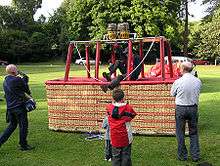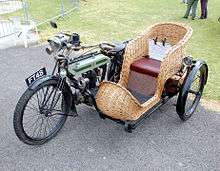Wicker

Wicker is a material made of plant stalks, branches or shoots formed by a kind of weaving into a rigid material, most often used for baskets or furniture.[1] Wicker is traditionally made of material of plant origin, but plastic fibers are now also used. Wicker is light yet sturdy, making it suitable for furniture that will be moved often like porch and patio furniture.[2] A variety of plants are used, from reeds, grasses (including bamboo), creepers such as rattan, and thin tree branches, especially willow. Rushwork and wickerwork are terms used in England.[3]
History
Wicker has been documented as far back as ancient Egypt, made from indigenous "reed and swamp grasses."[4] Middle-class families could only afford a few pieces, such as small tables.[5] However, archaeologists working on the tombs of the wealthy pharaohs (rulers) have uncovered a wider variety of wicker items,[6] including "chests, baskets, wig boxes, and chairs.".[4] Wicker even found use in the Achaemenid Empire on the battlefield, in shields.[7]
The popularity of wicker passed from Egypt and Persia to ancient Rome. Wicker baskets were used to carry items in Pompeii.[8] Furniture was manufactured out of wicker in the Roman style.[4] It has been proposed that the extensive use of wicker in the Iron Age (1200 BC – 400 AD in Europe) may have influenced the development of the woven patterns used in Celtic art. By the 16th and 17th centuries, wicker was "quite common"[4] in European countries like Portugal, Spain, and England.
Wicker received a boost during the Age of Exploration, when international sea traders returned from southeast Asia with a species of palm called rattan. Rattan is stronger than traditional European wicker materials,[6] although the rattan stem can be separated so the softer inner core can be used for wicker.
The 19th century brought immense popularity for wicker in Europe, England, and North America.[4] It was used outdoors as well as indoors. People in the Victorian Era believed it to be more sanitary than upholstered furniture.[4] It was inexpensive,[9] resisted harsh weather and was adaptable to many styles.[9]
In the United States, Cyrus Wakefield began constructing rattan furniture in the 1850s. He first used rattan that had been offloaded from ships, where it was used as ballast,[6] but as his designs became well-known, he began importing the material himself.[4] Wakefield's company became one of the leading industries in wicker furniture;[4] it later merged with the Heywood Chair Manufacturing Company (a wooden chair company[10] that had invented a mechanical process for weaving wicker seats[4]) to form the Heywood-Wakefield of Gardner, Massachusetts, one of the oldest and most prominent North American wicker manufacturers.[4]
In recent times, its aesthetic was influenced heavily by the Arts and Crafts movement at the turn of the 20th century.
Wicker is still a popular material. Antique wicker products are highly sought after by collectors.[11] Reproductions of furniture and accent pieces are also sold for indoor and outdoor use.[12][13] (In North America today, "rattan" and "wicker" are frequently used interchangeably.)[14] Wickerwork is an important industry in Poland, employing hundreds of skilled workers to create goods for export to western Europe.[15]
Manufacture
Wicker can be made from natural or synthetic materials, or a combination. In furniture, such as benches, chairs, stools and other seating devices, a frame is typically made of stiffer materials, after which more pliant material is woven into the frame to fill it.[16] In a smaller piece such as a basket, a strengthening frame is not needed so the entire piece is woven from the wicker material.[17]
Natural wicker is well known for its strength and durability, and for the high level of beauty and comfort that an expert craftsman can produce. Materials used can be any part of a plant, such as the cores of cane or rattan stalks, or whole thicknesses of plants, as with willow switches. Other popular materials include reed and bamboo. Natural wicker requires maintenance to keep it in good shape.
Synthetic types include paper-wrapped high tensile wire (using the Lloyd Loom process patented in the early 20th century), and plastic or resin. The synthetic wickers are often preferred for outdoor use ("all-weather wicker"). The frame material used in these more recent versions includes aluminum.[18]
Etymology
The word wicker is from the Middle English wiker, of Scandinavian origin.[1]
Image gallery
|
See also
References
- 1 2 "Wicker", The American Heritage® Dictionary of the English Language (Fourth ed.), Houghton Mifflin Company, 2000 (Updated in 2009), retrieved 2012-05-19 Check date values in:
|date=(help) - ↑ "Garden Furniture". Manchester, England: Alfresia.co.uk.
- ↑ Seymour, John (1984 copyright by Dorling Kindersley Limited, London. Text copyright 1984 by John Seymour). The Forgotten Arts A practical guide to traditional skills. page 54: Angus & Robertson Publishers. p. 192. ISBN 0-207-15007-9. Check date values in:
|date=(help) - 1 2 3 4 5 6 7 8 9 10 "From Egypt to the American Patio: The History of Wicker Furniture". Random History. 4 May 2007. Retrieved 11 October 2012.
- ↑ Kremen, Lisa (29 April 1997). "Ancient Egyptian Social Life: Professions". Archived from the original on May 27, 2007. Retrieved 11 October 2012.
- 1 2 3 Saunders, Richard (1990). Wicker Furniture: A Guide to Restoring and Collecting. Random House, Inc.
- ↑ http://classics.mit.edu/Herodotus/history.7.vii.html
- ↑ Willey, David (18 July 2005). "Rare Pompeii dinner set unveiled". Rome: BBC News. Retrieved 11 October 2012.
- 1 2 American Institute of Architects, San Francisco (2012). "Victorian Cottage & Wicker Furniture".
Wicker, another form of low-priced furniture, attracted even greater interest beginning in the 1850s and soon became a fixture in almost every American setting. Wicker furniture, suitable for parlor, porch or lawn linked the indoors and outdoors. Hundreds of patterns in wicker, mass-produced by dozens of forms across the country, illustrate the range and richness of Victorian fashion.
- ↑ "From Country Store to Modern Furniture: 100 Years of Progress". 2008. Retrieved 11 October 2012.
- ↑ "Dovetail Antiques: Fine American Wicker Furniture". Retrieved 11 October 2012.
- ↑ "Searching for Wicker (28 Results)". Manchester, England: Alfresia.co.uk.
- ↑ "Victorian Wicker Furniture". Retrieved 11 October 2012.
- ↑ "Rattan Wicker Furniture". Royal Palm Beach, Florida: Rattan Wicker Furniture Company. Retrieved 11 October 2012.
- ↑ Easton, Adam. "Poland revives wicker tradition". Rudnik-on-San, Poland: BBC News. Retrieved 11 October 2012.
- ↑ "What is wicker". Retrieved 11 March 2015.
- ↑ Ridgeon, Jonathan. "How to Weave a Wicker Basket: A practical guide". Retrieved 11 October 2012.
- ↑ "All Weather Wicker Garden Furniture". Manchester, England: Alfresia.co.uk.
External links
| Look up wicker in Wiktionary, the free dictionary. |
- Wakefield Library display (historic photos of factory and products)
- Wickerpedia, the wicker encyclopedia



